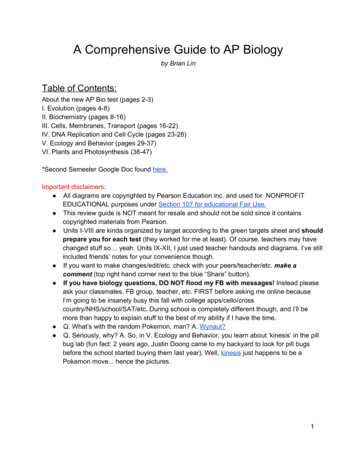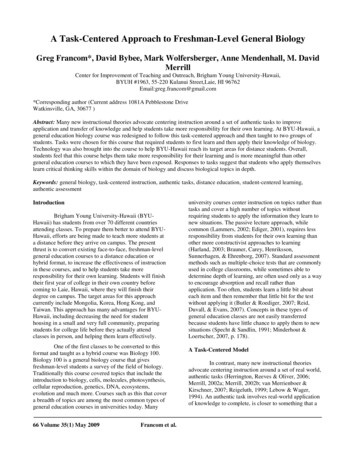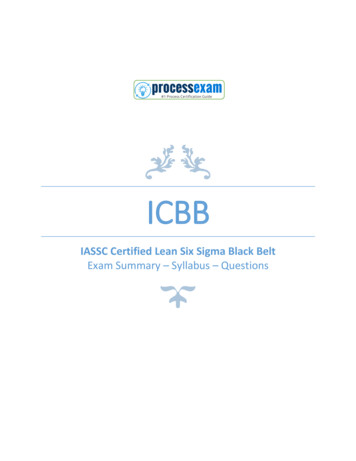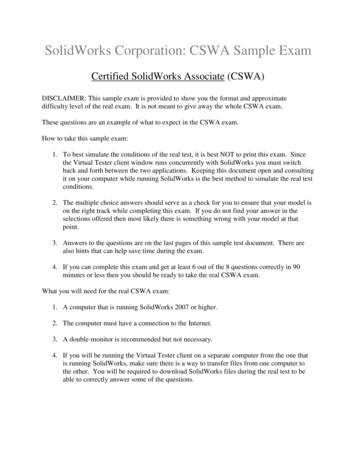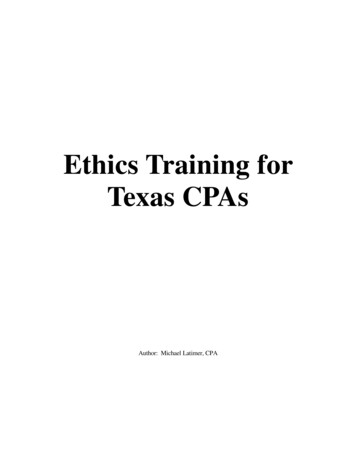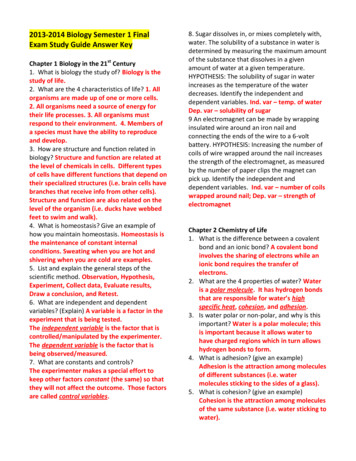
Transcription
2013-2014 Biology Semester 1 FinalExam Study Guide Answer KeyChapter 1 Biology in the 21st Century1. What is biology the study of? Biology is thestudy of life.2. What are the 4 characteristics of life? 1. Allorganisms are made up of one or more cells.2. All organisms need a source of energy fortheir life processes. 3. All organisms mustrespond to their environment. 4. Members ofa species must have the ability to reproduceand develop.3. How are structure and function related inbiology? Structure and function are related atthe level of chemicals in cells. Different typesof cells have different functions that depend ontheir specialized structures (i.e. brain cells havebranches that receive info from other cells).Structure and function are also related on thelevel of the organism (i.e. ducks have webbedfeet to swim and walk).4. What is homeostasis? Give an example ofhow you maintain homeostasis. Homeostasis isthe maintenance of constant internalconditions. Sweating when you are hot andshivering when you are cold are examples.5. List and explain the general steps of thescientific method. Observation, Hypothesis,Experiment, Collect data, Evaluate results,Draw a conclusion, and Retest.6. What are independent and dependentvariables? (Explain) A variable is a factor in theexperiment that is being tested.The independent variable is the factor that iscontrolled/manipulated by the experimenter.The dependent variable is the factor that isbeing observed/measured.7. What are constants and controls?The experimenter makes a special effort tokeep other factors constant (the same) so thatthey will not affect the outcome. Those factorsare called control variables.8. Sugar dissolves in, or mixes completely with,water. The solubility of a substance in water isdetermined by measuring the maximum amountof the substance that dissolves in a givenamount of water at a given temperature.HYPOTHESIS: The solubility of sugar in waterincreases as the temperature of the waterdecreases. Identify the independent anddependent variables. Ind. var – temp. of waterDep. var – solubility of sugar9 An electromagnet can be made by wrappinginsulated wire around an iron nail andconnecting the ends of the wire to a 6-voltbattery. HYPOTHESIS: Increasing the number ofcoils of wire wrapped around the nail increasesthe strength of the electromagnet, as measuredby the number of paper clips the magnet canpick up. Identify the independent anddependent variables. Ind. var – number of coilswrapped around nail; Dep. var – strength ofelectromagnetChapter 2 Chemistry of Life1. What is the difference between a covalentbond and an ionic bond? A covalent bondinvolves the sharing of electrons while anionic bond requires the transfer ofelectrons.2. What are the 4 properties of water? Wateris a polar molecule. It has hydrogen bondsthat are responsible for water’s highspecific heat, cohesion, and adhesion.3. Is water polar or non-polar, and why is thisimportant? Water is a polar molecule; thisis important because it allows water tohave charged regions which in turn allowshydrogen bonds to form.4. What is adhesion? (give an example)Adhesion is the attraction among moleculesof different substances (i.e. watermolecules sticking to the sides of a glass).5. What is cohesion? (give an example)Cohesion is the attraction among moleculesof the same substance (i.e. water sticking towater).
6. Why is the fact that water has a high specificheat important? This property is importantin cells because processes that produceusable chemical energy in cells release a lotof heat; water absorbs the heat, whichhelps to regulate cell temperatures andmaintain homeostasis.7. What is a monomer? A monomer is eachsubunit in a complete molecule. What is apolymer? A polymer is a large molecule, ormacromolecule, made of many monomersbonded together.8. Fill in the chart below.PolymerMonomer FunctionFoodsCarbohydrateLipidProteinNucleic acidsGlucoseGlycerolAmino acidsNucleotidesWhat thebody uses itfor?What types offoods do youeat to get it?Brokendown toprovideusableenergy tocells.Brokendown toprovideusableenergy tocells; someare parts ofa cell’sstructure.Formovement,eyesight, ordigestion.Sugars andstarches (i.e.cereal,pasta,sugars, etc.Providedetailedinstructionsfor how tobuildproteins.Fats and oils(i.e. Meat,butter, oliveoil, peanutoil, etc.)Your bodymakes 12 ofthe aminoacids. Otherscome frommeat, beans,and nuts.DNA andRNA9. 2HO2 H2 O2 Explain why this is achemical reaction; label the reactants andthe products of this reaction. 2HO2 is thereactant and H2 O2 are the reactants. Thisis a chemical reaction in which a compoundis being broken apart.10. What is a catalyst? (give an example) Acatalyst is a substance that decreases theactivation energy needed to start achemical reaction. It also increases the rateof the chemical reaction.11. What is an enzyme? (give an example)Enzymes are catalysts for chemicalreactions in living things (i.e. amylase is anenzyme in saliva that breaks down starch).12. Use the diagram above to explain how anenzyme works.Substrates bind to an enzyme at certain placescalled “active sites”. The enzyme bringssubstrates together (or breaks them apart) andweakens their bonds. The catalyzed reactionforms two products that are released from theenzyme.Chapter 3 Cells and Organelles Cell Theory – list the 3 parts of the celltheoryAll organisms are made of cells. All existingcells are produced by other living cells. Thecell is the most basic unit of life. Two types of Cells – describe thedifference between prokaryotic andeukaryotic cellsProkaryotic cells do not have a nucleus orother membrane-bound organelles. Theyconsist of a cell membrane, cytoplasm, andDNA. All single-celled organisms areprokaryotic (i.e. bacteria)Eukaryotic cells have a nucleus and othermembrane-bound organelles. The geneticinformation (DNA) is inside the nucleus.Eukaryotes may be multi-cellular or singlecelled organisms (i.e. plant & animal cells).
Organelles :o What are they? Structuresspecialized to perform distinctprocesses within a cell (i.e. nucleusprotects a cell’s DNA).o Describe the functions of thefollowing organelles and be ableto pick them out of a diagram: Nucleus – the storehouse for most of the genetic information (DNA). Servesto protect DNA; the nucleolus is in thenucleus.Mitochondria – bean-shapedorganelle that has two membranes;responsible for supplying energy to thecell.Lysosomes – membrane boundorganelles that contain enzymes. Theydefend a cell from invading viruses andbacteria; they also break down damaged or worn-out cell parts.Chloroplast – organelle found inplant cells that carry out the process ofphotosynthesis by converting carbondioxide, water, and solar energy intoglucose and oxygen.Ribosomes – tiny organelles that linkamino acids together to form proteins.Ribosomes are either on the rough ERor in the cytoplasm.Vesicles – small membrane boundsacs that divide some materials fromthe rest of the cytoplasm and transportthese materials from place to placewithin the cell.Golgi Apparatus – closely layeredstacks of membrane-enclosed spacesthat process, sort, and deliver proteins.Endoplasmic Reticulum (ER) – aninterconnected network of thin, foldedmembranes; the production of lipidsand proteins occurs in the ER. Thereare two types: smooth and rough; therough ER is studded with ribosomes.Cell membrane – consists of adouble layer of phospholipidsinterspersed with a variety of othermolecules. The cell membrane forms aboundary between the cell and theoutside environment and controls thepassage of materials into and out of acell. Cell wall – a rigid layer that givesprotection, support, and shape to plantcells.Phospholipid Bilayer What is it made of (which parts are polarand which are non-polar)? A phospholipid is composed of three basic parts: acharged phosphate group, glycerol, and twofatty acid chains. The head is polar and thefatty acids chains are nonpolar. What is selective permeability? The cellmembrane has the property of selectivepermeability which means it allows some,but not all, materials to cross.Passive Transport – what is it? The movement ofmolecules across a cell membrane without energyinput from the cell. Diffusion – What is it? The movement ofmolecules in a fluid or gas from aregion of higher concentration to aregion of lower concentration. What is a concentrationgradient? The difference in theconcentration of a substance fromone location to another. Osmosis – What is it? The diffusion of water. In what direction does the watermove in the following solutions:o hypotonic – into the cello isotonic – into and out ofothe cell at an equal ratehypertonic – out of thecell Facilitated Diffusion – What is it? The diffusion of molecules across a membranethrough transport proteins.How does it work? Transportproteins make it easier formolecules to enter or exit a cell.This is still a form of passivetransport because molecules movedown a concentration gradient.
Active Transport – what is it? A process in whicha molecule is driven across a membrane from aregion of lower concentration to a region of higherconcentration. Endocytosis –o What is it? The (entrance) processof taking liquids or fairly largemolecules into a cell by engulfingthem in a membrane.o Phagocytosis – a type ofendocytosis in which the cellmembrane engulfs large particles. Exocytosis –o What is it? The release (exit) ofsubstances out of a cell by thefusion of a vesicle with themembrane.o How does it work? During thisprocess, a vesicle forms aroundmaterials to be sent out of the cell.The vesicle then moves toward thecell’s surface where it fuses withthe membrane and lets go of itscontents.Chapter 4 Cells and Energy1. What is ATP? Adenosine triphosphate is amolecule that transfers energy from thebreakdown of food molecules to cellprocesses. Energy is transferred when achemical bond is broken by releasing aphosphate group and energy is released.2. What is the difference between theenergy stored in food and the energy inATP? Food molecules store chemicalenergy in their bonds. Food is broken downinto smaller molecules that are brokendown further to transfer this energy to ATP.3. What is the purpose of cellularrespiration? The purpose of cellularrespiration is to release chemical energyfrom sugars and other carbon-basedmolecules to make ATP when oxygen ispresent. This is an aerobic process (requiresoxygen).4. Where does cellular respiration occur? Inthe mitochondria because they make mostof a cell’s ATP.5. What is aerobic respiration? (include theadvantages and disadvantages) Aerobicrespiration is a process that requiresoxygen to take place. Cellular respiration isan aerobic process.6. What is anaerobic respiration? (includethe advantages and disadvantages)Anaerobic respiration is a process that doesnot require oxygen to take place. Glycolysisand fermentation are anaerobic process.Match the following processes with thestatements below:a. Glycolysisc. Fermentationb. Kreb’s cycled. Electron Transport chain7. Which process(es) are aerobic? B & D8. Which process(es) are anaerobic? A & C9. Which process(es) starts with sugar andends with pyruvate? A10. Which process(es) allows glycolysis tocontinue if oxygen is not readilyavailable? C11. Which process(es) produces the mostATP? D12. Which process(es) has the products of:2 ATP, 6 CO2, 8 NADH, and 2 FADH? B13. Which process produces Lactic Acid? C14. Which process is the first step of cellularrespiration? B15. What are the products of glycolysis? 2ATP & two pyruvates (three-carbonmolecules)16. How many ATPs can be produced by theelectron transport chain? 34
On the line below each picture, classify the organism as either an AUTOTROPH or a HETEROTROPH.HeterotrophAutotrophHeterotrophHint: What color are mushroomsPHOTOSYNTHESIS: An OverviewPlants gather the sun’s energy with light-absorbing MOLECULES called chloroplasts .A. thylakoidsB. pigmentsC. chloroplastsD. glucoseThe Calvin cycle is another name for D. light-independent reactionsA. photosynthesisB. the electron transport chainC. light-dependent reactionsD. light-independent reactionsHow is the Calvin cycle different from the light-dependent reactions?A. It takes place in chloroplasts.B. It takes place in the stroma.C. It requires light.D. It takes place in the thylakoid membraneOxygen produced during the light-dependent reaction is C. is released into the atmosphere .A. used in the Calvin cycle to make sugarB. joined with the NADPH to make waterC. is released into the atmosphereD. None of these, oxygen is NOT produced by the light-dependent reactionUSE THE LETTERS IN THE DIAGRAM AT THE LEFT TO IDENTIFY:B stromaA thylakoidC granum
USE WORDS FROM THE WORD BANK TO FILL IN THE CHART COMPARING ANDCONTRASTING THE LIGHT-DEPENDENT REACTIONS AND THE CALVIN CYCLE: (You can usethem more than once!)in stromain thylakoid membraneRequires lightLOCATIONREACTANTSPRODUCTSLIGHT?O2ATPDoesn’t require lightCO2H2OSUGARS (glucose)LIGHT-DEPENDENTREACTIONSCALVIN CYCLEin thylakoid membranein stromaH2OCO2O2SUGARS (glucose)Requires lightDoesn’t require lightCELLULAR RESPIRATIONMULTIPLE CHOICEC. Glycolysis is the first step in cellular respiration that begins releasing energy stored in glucose.A. Alcoholic fermentationB. Lactic acid fermentationC. GlycolysisD. Electron transport chainIf oxygen is NOT present, glycolysis is followed by B. fermentation .A. Krebs cycleB. fermentationName the 3 carbon molecule produced when glucose is broken in half during glycolysis.A. pyruvic acidB. lactic acidC. Acetyl-CoAD. citric acidSince fermentation does not require oxygen it is said to be B. anaerobic .A. aerobicB. anaerobicWhich of the following shows the correct sequence during cellular respiration?A. Electron transport chain glycolysis Krebs cycleB. Glycolysis Electron transport chain Krebs cycleC. Krebs cycle Electron transport chain glycolysisD. Glycolysis Krebs cycle Electron transport chainBecause cellular respiration requires oxygen it is said to be A. aerobicA. aerobicB. anaerobicHow many total ATP molecules are produced by 1 molecule of glucose completing cellular respiration?262436
Which stage of cellular respiration produces the most ATP?A. glycolysisB. Krebs cycleC. Electron transportD. Acetyl-CoA chargingWrite the complete overall chemical equation for cellular respiration using chemical symbols instead ofwords:C6H12O6 6O2 6H2O 6CO2 ATPTell the kind of fermentation used in each example (alcoholic or lactic acid):Yeast uses this to make bread dough rise alcoholic fermentationYour muscle cells use this during rapid exercise when oxygen is low lactic acid fermentationBacteria and yeast use this to make beer and wine alcoholic fermentationBacteria use this to make cheese, yogurt, and sour cream lactic acid fermentation
Chapter 5 Cell Growth and DivisionCell Cycle Name and describe what occurs during eachstep of the cell cycle. The cell cycle is theregular pattern of growth, DNA duplication, andcell division that occurs in eukaryotic cells. Thefour main stages of the cell cycle are: Gap (G1),Synthesis (S), Gap 2 (G2) and Mitosis (M).Gap 1 – cells grow, carry out normal functions,and replicate their organelles; checkpoint.Synthesis – DNA is copiedGap 2 – additional growth and checkpointMitosis – cell divides its nucleus and itscontents (cytokinesis occurs immediately after);resulting in two identical daughter cells. What types of checks occur during the G1and G2 stages before the cell can move on tothe next step? Checks for undamaged DNA and What occurs during Interphase? (draw andexplain)See pg. 141of textbookThe cell copies its DNA and grows in preparation fordivision. The DNA is loosely organized during interphase. What occurs during Prophase? (draw andexplain)See pg. 141of textbookadequate cell size.Mitosis What is the purpose of mitosis?The purpose of Mitosis is to produce twoidentical daughter cells (somatic/body cells)that are diploid (46 chromosomes each). What do you end up with at the end ofmitosis?two identical daughter cells What is the difference between achromosome and a chromatin? (label theparts of the figure below)A chromosome is one long continuous thread ofDNA that has numerous genes along withregulatory information. A chromatin is theloose combination of DNA and proteins.centromerechromatidDNA and proteins condense into tightly coiled chromosomes. The nuclear membrane breaks down, centriolesbegin to move to opposite poles and spindle fibers startto form. What occurs during Metaphase? (draw andexplain)See pg. 141of textbookSpindle fibers attach to each chromosome. They alignthe chromosomes along the equator. What occurs during Anaphase? (draw andexplain)See pg. 141of textbookchromosome
Chromatids separate to opposite sides of the cell. What occurs during Telophase? (draw andexplain)Cytokinesis divides cytoplasm between two daughtercells, each with a genetically identical nucleus.Cancer What is cancer? Uncontrolled cell division Why does cancer occur? When regulation ofthe cell cycle breaks down, when mutationoccurs, and due to exposure to carcinogens (i.e.ultraviolet radiation and pollutants).See pg. 141of textbookNuclear membranes start to form, chromosomes beginto uncoil, and the spindle fibers fall apart. The cellpinches in the middle as it prepares to go throughcytokinesis. What is the difference between Benign andMalignant tumors? Benign tumors arecharacterized by cancer cells that remainclustered (or clumped) together. These tumorsare usually harmless. Malignant tumors havecancer cells that metastasize (break away) andspread, forming other tumors. What occurs during Cytokinesis? (draw andexplain)See pg. 141of textbook Why are Malignant tumors so dangerous?Malignant tumors are dangerous because theycan break away and spread.Chapter 6Meiosis and MendelMeiosis How are somatic cells different from gametes?Somatic cells are body cells (such as liver cells, heart cells, skin cells, etc.). These cells are diploid (2n) andhave 46 chromosomes; they are produced through the process of mitosis. Gametes are sex cells (eggs andsperm) . Gametes are haploid (n) which means they have 23 chromosomes; they are produced through theprocess of meiosis. How do haploid cells differ from diploid cells?Haploid cells have only one copy of each chromosome and are represented as n. Gametes are haploid cells.The haploid number in humans is 23.Diploid cells have two copies of each chromosome: one copy from mom and one copy from dad. They arerepresented as 2n. Body cells are diploid. The diploid number in humans is 46. How do autosomes differ from sex chromosomes?Autosomes are chromosome pairs 1-22 and they directly affect body traits (physical traits). Sexchromosomes are chromosome pair 23 and directly affect the sexual characteristics of an organism (male orfemale). What genetic material does an organism receive from their mother?23 chromosomes come from the mother; 22 of these are autosomes and 1 is a sex chromosome (X). What genetic material does an organism receive from their father?23 chromosomes come from the father; 22 of these are autosomes and 1 is a sex chromosome (X or Y). What occurs during fertilization?Fertilization is the actual fusion of an egg and a sperm cell.
Draw homologous chromosomes.X XDADMOM Illustrate crossing over.Refer to Figure 6.20 on textbook page 190. Illustrate genetic linkage.Genes A and B are linked. Genes C and D are also linked.These genes are linked due to the fact that they are so closetogether, so they are most likely to be inherited together. What is the purpose of meiosis?Meiosis is a form of nuclear division that creates 4 haploid cells (gametes) from one diploid cell. Thisprocess involves two rounds of cell division – Meiosis I and Meiosis II. The final product of meiosis is 4unique gametes (eggs or sperm). What are the stages of meiosis? (draw and explain)o Process of Meiosiso Cells go through (1 round/ 2 rounds) of division to produce genetically different (haploid/diploid) cells.o How do homologous chromosomes differ from sex chromosomes?Homologous chromosomes are two separate chromosomes – one inherited from the motherand one from the father – that have the same length and general appearance. Sexchromosomes are chromosomes that directly control the development of sexual characteristics.Humans have two very different sex chromosomes - X and Y. When do homologous chromosomes separate? Homologous chromosomes areseparated during Anaphase I of Meiosis I. When do sister chromatids separate? Sister chromatids are separated duringAnaphase II of Meiosis II.
o Gametogenesis What does the sperm contribute to the embryo? DNA What does the egg contribute to the embryo? DNA, organelles, molecular buildingblocks, and other materials such as nutrients that an embryo needs to begin life.Chapter 7Extending Mendelian GeneticsChromosomes and Phenotype What is a carrier? What would be the genotype for a carrier of Cystic Fibrosis (C-normal, c- Cysticfibrosis)?A carrier is someone who does not have a disorder but carries the recessive allele and can pass on thedisease-causing allele to offspring.The genotype for a carrier of Cystic Fibrosis would be Cc. What are sex-linked genes? Genes that are located on the sex chromosomes (X and Y chromosomes). What are the sex chromosomes for males? XY for females? XX Do sex-linked traits occur more frequently in males or in females? Males Why? Males have twodifferent sex chromosomes (XY) so they cannot have X-chromosome inactivation to mask alleles on onechromosome like females can due to the fact that they have two of the same sex chromosomes (XX).Complex Patterns of Inheritance What is incomplete dominance? Provide an example.Incomplete dominance results in a heterozygous phenotype that is a blend of the two homozygousphenotypes; neither allele is completely dominant or recessive (i.e. red flower crossed with a white floweryields pink flowers). What is codominance? Provide an example.Codominance results in a heterozygous genotype that equally expresses the traits from both alleles; bothalleles of a gene are expressed completely and neither is dominant or recessive (i.e. red flower crossed witha white flower yields white flowers with red speckles). Identify the following as examples of incomplete dominance or codominance: a red flower is crossed with a white flower and the offspring are all pink incomplete dom. a black cat and a white cat have kittens that are black and white codominance a mother with A blood and a father with B blood have a son with AB blood codominance a green betta fish and a blue betta fish have offspring that are teal incomplete dom. Could a baby with O blood have parents with A and B blood? Draw a Punnett Square to explain.IAiIBIA IBIB iiIA iiiYes, these parents could have a baby with type O blood if bothparents were heterozygous (IAi and IBi) for their blood typesthen they could each give the baby a recessive allele, whichwould result in type O blood (ii).
Define polygenic. Give two examples of polygenic traits. Polygenic traits are traits produced by two ormore genes. Examples of polygenic traits are eye color and skin color. What is represented on the axis (or outside) of a Punnett square? Genotype of parents What is represented on the inside of a Punnett square? Possible genotypes of offspringHuman Genetics and Pedigrees What is a pedigree? How is it useful? A pedigree is a chart that can trace the phenotypes andgenotypes in a family to determine the chance that child might have a certain genetic disorder. It isuseful because it allows you to determine the chances of offspring inheriting various traits throughgenerations. squares on a pedigree represent males circles represent females a circle that has been halfway filled in means: the female is a carrier of the trait or disease a circle that has been completely filled in means: the female has the trait or disease Can a male be a carrier of an autosomal trait? Yes of a sex-linked trait? No How does a son inherit colorblindness? Can he inherit colorblindness from his father?A son inherits colorblindness if the X chromosome given to him by his mother has the allele forcolorblindness on it. A son cannot inherit colorblindness from his father because he only receives a Ychromosome from his father. How does a daughter inherit colorblindness?A daughter can inherit colorblindness if her mother is a carrier of the trait and her father is colorblind asthey can both give her an X chromosome with the allele for colorblindness on it, which would cause her tobe colorblind. What is a karyotype? How can it be used to study human chromosomes?A karyotype is a picture of all of the chromosomes in a cell. It can be used to study abnormalities inchromosomes. For example, an individual with 3 chromosomes, instead of just two, on their 21 stchromosome pair would have Trisomy 21.
reactions in living things (i.e. amylase is an enzyme in saliva that breaks down starch). 12. Use the diagram above to explain how an enzyme works. Substrates bind to an enzyme at certain places hem apart) and forms two products that are released from the enzyme. Chapter 3 Cells and Org




